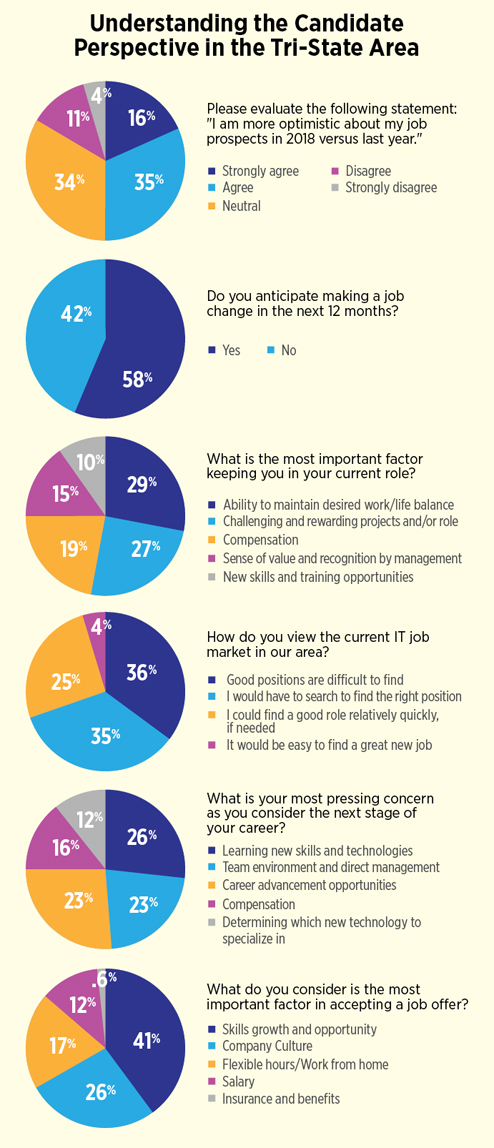Fifty-eight percent of technology professionals within this region plan to switch jobs in 2019, according to the report “Top 5 Challenges Facing Tri-State CIOs Today: Current Trends in Metro New York, Connecticut, and New Jersey” published by Benchmark IT-Technology Talent. The regional number is nearly five times the national average and the new report also pointed out there are more than 135,000 open tech jobs in the tri-state area, not counting Manhattan.
“There is definitely a big talent shortage out there,” observed John Bemis, president of Stamford-based Benchmark IT, a staffing firm focused on the high-tech industry, who added that the vibrant economy is encouraging more people to spread their wings. “Since the financial crisis, this is the most robust market we”™ve seen ”” not just in hands-on positions, but also in management positions available, which was not the case a year ago. The perception is that there are a lot more opportunities than there were.”
The technology industry leads all employment sectors for annual employee turnover, with a 13.2 percent annual rate. This has become more pronounced following the post-recession years, when minimal opportunities and stagnant wages left a sour taste with many IT professionals.
“People had felt sort of stuck in their positions after the economy was not good,” Bemis added. “There wasn”™t a lot of job satisfaction and employers had been slow to work on skills development and training. A lot of people we”™re talking to are interested in making the change ”” they just haven”™t had the opportunities until the past year.”
 What is causing the IT professionals to consider pulling up stakes? Much to Bemis”™ surprise, the issue is not about money.
What is causing the IT professionals to consider pulling up stakes? Much to Bemis”™ surprise, the issue is not about money.
“Salary wasn”™t the only factor, or even the biggest factor for a lot of people,” he said. “We”™ve been sensing a boiling pot under wages, but we found that other aspects of jobs were as much or more important than just salary.”
Benchmark IT”™s report included a “Candidate Perspective Survey” that found “team environment and direct management” (23 percent) and “learning new skills and technologies” (26 percent) were top factors when considering a job change, rather than salary. The survey also found a combined 42 percent of respondents believed “challenging and rewarding projects” and a sense of “value and recognition” were the most important factors when choosing to remain in their current positions.
Filling an IT jobs void is not going to be simple, Bemis warned, and strategies that worked in the recent past will not be successfully reprised.
“A lot of companies tried offshore outsourcing and found a lot of friction in getting the projects done efficiently,” he said. “Even though the costs seemed attractive ”” with maybe a 75 percent reduction in annual costs per employee ”” if it takes four times as many workers to do the job and it”™s only 25 percent as expensive, you”™re not really getting any savings. Even the offshore people had problems ”” there is huge turnover in India. A lot of our clients are starting to bring the projects back.”
And another endeavor of the recent past, importing tech workers via the H-1B visa program, is still somewhat viable, despite apprehension within the tech industry that the program would fall victim to the Trump immigration policies.
“There was a concern when the new administration came in two years ago that there would be cuts to the program, but that hasn”™t happened,” he stated. “It continued on status quo, with small changes in the law that slows down renewals of those visas. The cap on those visas has stayed relatively the same. There has been a little bit more enforcement on the companies that grab the majority of the visas, and we”™re starting to see some clients do visa sponsorship for a full-time job because they”™re in demand.”
As for hoping that Generation Z would come to the rescue, Bemis glumly noted, “There definitely aren”™t enough kids coming out of school. There are a lot of programs to get kids interested from elementary school age in technology, but it”™s very slow.”
And if there weren”™t enough problems, there is also the news of Amazon”™s new headquarters coming to Long Island City. Although Bemis noted that was still in the future and it was not clear what types of jobs will be brought to Amazon, he stated Amazon would “attract a certain number of workers and create new openings in a lot of companies.”
So, what can companies do to keep their IT professionals from defecting? The answer, Bemis believed, was listening to what their tech staffs were looking for in terms of job satisfaction. Bemis recommended that companies offer their IT employees ongoing skills training as part of their talent acquisition and retention strategies, with particular attention given to developing technologies, including cloud computing and DevOps.
“With national tech unemployment at near zero percent, it”™s important to consider every means possible to ensure a fully staffed and productive technology team,” Bemis said.
If the region has one advantage going for it, Bemis acknowledged, that would be its location ”” especially for maintaining a local talent pool from being lured to the Big Apple.
“People who live in the suburbs would rather not go into New York City,” he said. “They can now get almost a competitive salary out here in the suburban areas. People will commute up to an hour for a little bit higher salary, but people want the quality of life you can get from a more local position.”




















